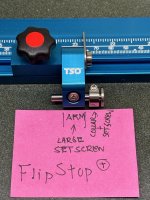I have two TSO PE squares and the guide rail system.
The system itself is easy to set up and calibrate, however, all of my cuts are 2/3mm out from one end to the other.
From the start of the cut to around the middle they are decent, but the last half always has a variance of 2/3mm and it's getting really frustrating.
Here are the things I have tried:
- Using only one TSO square
- Re-calibrating
- Bought a new smaller Festool guide rail (I needed it anyway)
- Clamped down
None of the above seems to work. I can't understand how it can consistently be out by 2/3mm.
Will the splinter guard and how it is cut be an issue? It's a bit inconsistent, but then end where is does vary does give the same bang on cut.
However, I did buy a new rail and cut the splinter guard.
The only thing I can think of is the splinter guard? The rail itself stays in the garage and hasn't been used much and can't see any visible dinks.
Thanks
The system itself is easy to set up and calibrate, however, all of my cuts are 2/3mm out from one end to the other.
From the start of the cut to around the middle they are decent, but the last half always has a variance of 2/3mm and it's getting really frustrating.
Here are the things I have tried:
- Using only one TSO square
- Re-calibrating
- Bought a new smaller Festool guide rail (I needed it anyway)
- Clamped down
None of the above seems to work. I can't understand how it can consistently be out by 2/3mm.
Will the splinter guard and how it is cut be an issue? It's a bit inconsistent, but then end where is does vary does give the same bang on cut.
However, I did buy a new rail and cut the splinter guard.
The only thing I can think of is the splinter guard? The rail itself stays in the garage and hasn't been used much and can't see any visible dinks.
Thanks

